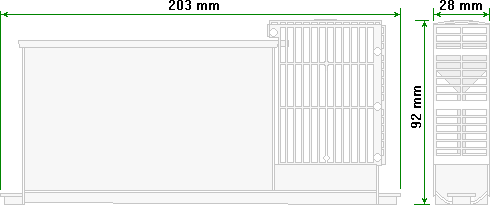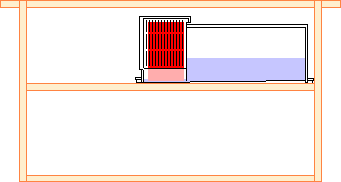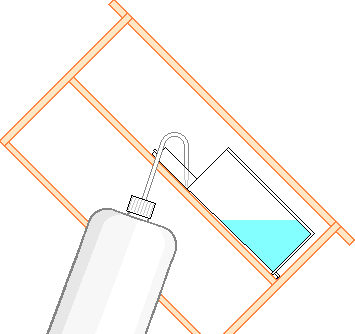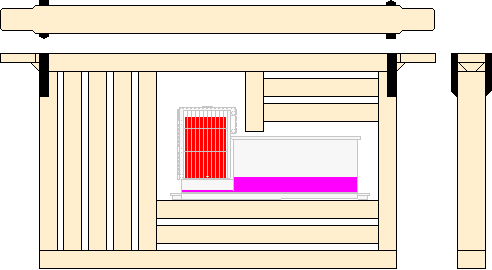Special or Unusual Frames
Test Results
Evaporators & essential Oils
|
|
|
|---|
|
Special or Unusual Frames Test Results Evaporators & essential Oils |
The Nassenheider Evaporator |
|---|
|
The device was developed for slow continuous evaporation of 60% formic acid for combating varroa mites. This text draws heavily on various leaflets issued by the manufacturer. (Nassenheider can be contacted via the links and phone numbers given below.) |

|
|---|
Joachim Weiland Werkzeugbau
Zimmermannsgasse 2
D-15366 Dahlwitz-Hoppegarten (near Berlin)
|
Web: www.nassenheider.com Phone: +49 3342 303121 |
Email: info@nassenheider.com Fax: +49 3342 303123 |
|---|
The evaporator is protected by German patent No. DBP D.D. 292141.
Experiments were carried out Dr. Eva Rademacher et al. from the "Institut für Zoologie der Freien Universität Berlin". The results are detailed in the link at top left.
Formic acid is a preservative and disinfectant used in the food industry and it is a naturally occurring ingredient in honey. It has been used for many years, against varroa mites, with no known cases of resistance developing.
Successful treatment depends on the following:-
1, Presence of brood throughout the treatment.
2, Placing the evaporator close to the focus of bee activity and the brood. Bees regulate a constant temperature of 35° C next to the brood, that is why the evaporation rate is largely independent of external temperatures.
Timing of treatment during the year
1, Two treatments are recommended, lasting 10 - 14 days each. The first should be done in July/August after the harvest, with a repeat treatment before brood rearing ends in September/October.
2, In cases of heavy infestation or in warmer countries, where there is no clear break in flowering and brood production, at least two treatments, each following a harvest, should be contemplated.
The Nassenheider evaporator consists of three components
1, A graduated plastic tank that holds the acid.
2, A fibrous, absorbent sheet wick (these can be cut from 'fume pads', sold by beekeeping appliance dealers.
3, A ventilated plastic cover shroud that surrounds the wick.
Preparations for treatment
1, Remove any honey supers for extraction before treating the remaining colony.
2, Temporarily cover the mesh of Open Mesh Floors.
3, Install an entrance block with entrance about 125 mm x 9 mm.

Instructions for use
1, Detach the ventilated cover.
2, Fix evaporator in the upper portion of a divided brood frame using two non corrosive screws. (Nylon nuts and bolts can be used here... M5 or 2BA.)
3, Tilt the frame and slowly deliver 80 cm3 of 60% formic acid into the holding tank using a measuring cylinder, injection syringe or squeeze bottle.

For a continuous treatment of 3 - 4 weeks the evaporator has to be completely filled (180 cm3).
4, Always use a new wick (shown red) for each filling. Insert the wick into the slot in the cover, clip the cover back in place while locating the wick positively in the forked holder.
5, Place the prepared frame inside the first brood-free frame.
6, If the colony is using two brood chambers, a second evaporator should be installed in the second brood chamber in the same position, but on the opposite side of the nest.
7, Within the first 2 or 3 days remove the frame to check the acid level and calculate the daily evaporation rate.
Maintain the following average daily evaporation rate when using 60% formic acid:-
15 - 20 cm3 (ml) in Summer, or 6 - 10 ml in Autumn
If the evaporation rate is below 6 ml per day, the treatment may not be successful!
8, If there is a measurably higher evaporation rate (caused by a large amount of fanning activity) shorten the wick to reduce its size. This will allow the evaporation rate to be brought within the limits in 7, above. If a high evaporation rate empties the chamber in less than 10 days, it is recommended to top up the acid. A higher rate of evaporation or a longer lasting treatment causes no apparent harm.
Selection of the wick
The evaporating surface is calculated as follows:-
Wicks are nominally 50 mm wide.
Small wick:- (50 mm x 58 mm) has an effective evaporating surface of 36 mm x 50 mm = 18 cm2 per side.Large wick:- (50 mm x 82 mm) effective evaporating surface 60 mm x 50 mm = 30 cm2 per side.
Manufacturer's note, due to the cutting process the sizes of the wicks may vary by a few millimeters. These small area differences are too small to affect the evaporation rate seriously. The other influences on the evaporation rate (ventilation by the bees etc.) are always much larger.
Generally the smaller wick is used... (50 mm x 58 mm). However if the evaporation rate is found to be below the recommended rate of 15 ml per day in Summer or 6 ml per day in Autumn), the larger wick (50 mm x 82 mm) should be used. If the rate is too high (> 40 ml per day in Summer and > 20 ml per day in Autumn), the wick should be shortened to reduce evaporation.
Important... The cover of the main tank is welded and must not be removed, its sealing is essential for proper functioning.
Safety precautions
1, Pay attention to the formic acid manufacturer's safety instructions!
2, Wear Neoprene safety gloves and safety glasses while working with formic acid, do not inhale the vapour.
3, Formic acid causes cauterisation (Burns) on contact with skin.
4, Splashes on the skin or in the eyes should be drenched with copious amounts of clear water, consult a doctor after contact with formic acid.
5, Keep formic acid away from children!
Safety is important always have available... a two litre plastic soft drinks bottle full of plain tap water. Stand this upright, and with it's top OFF, close by where you are working. In the event of an accident the water can be poured immediately onto a splash or the bottle can be squeezed to force water into an eye that has had a splash. Hopefully you will never need to use it, in which case it can be drunk.
Formic acid is corrosive and will damage metal fittings... Use stainless wire in frames (or nylon fishing line), plastic frame runners are appropriate in brood boxes.
The Nassenheider evaporator frame
My method of installation of the Nassenheider unit is somewhat different, as my intended use was with essential oils rather than formic acid. The bees more likely to build comb in any spaces during periods of use that may be much longer than that used with formic acid for varroa treatment, but I see no reason why it would not be as effective for acid evaporation.

This evaporator is smaller than the one illustrated at the top of the page and only has a tank capacity of 150 ml. The frame is constructed from 28 mm x 18 mm PAR (planed all round) stock. The one illustrated is 'British Standard' size and is fabricated using gluing and screwing (stainless screws would be an advantage if formic acid is your intended filling). The gaps between adjacent bars are 7 mm and the black blocks are cut from plastic 'Hoffman converter clips'.
Scale = 1 pixel per mm
When completed there is a surprising amount of weight to this assembly and this should ensure that it hangs vertical when in a hive.
I made this prototype several years ago, I have been busy doing other things since then, and so the intended testing has not yet been done... Maybe this season, maybe next.
The essential oils that I am considering are:-
Thyme oil,
Methyl salicylate (Oil of Wintergreen)
Another 'aromatic' is Turpineol, which is referred to in some elderly texts as a treatment for acarine.
One problem that I have considered is that some oils may form a skin on the surface of the wick and thus limit further evaporation.
Dave Cushman.
Page created 05/03/2002
Page updated 06/12/2022
Written... 25 February to 05 March 2002, Upgraded... 01 September 2005,
|